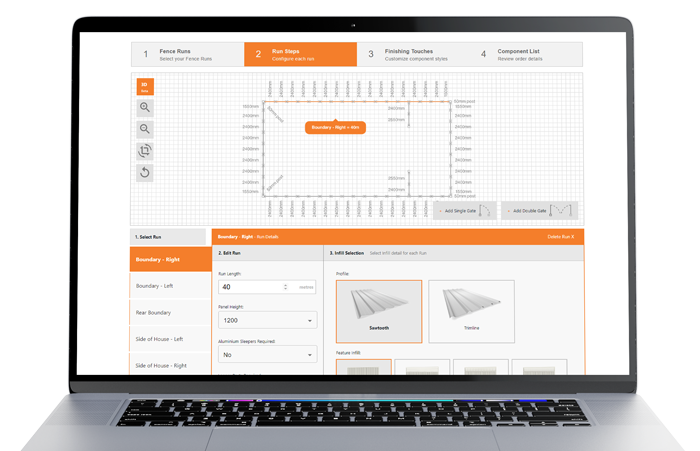Colorbond® Installation Considerations

Colorbond® Steel Fencing is a popular choice for residential and commercial fencing due to its durability, low maintenance, and modern look. However, installing Colorbond® Steel Fencing requires careful consideration and planning to ensure a successful and long-lasting installation.
Factors such as site preparation, choosing the right Colorbond product, selecting the right installation method, and complying with local regulations must all be taken into account to achieve a high-quality Colorbond® Steel Fence installation. In this article, we will explore the key considerations to keep in mind when installing a Colorbond® Steel Fence.

Our Panel Styles

Standard
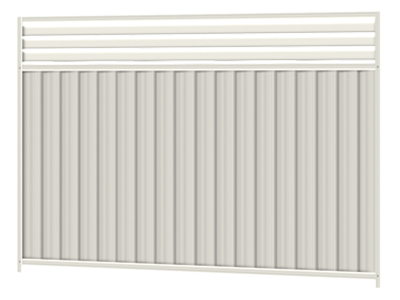
Breezeway
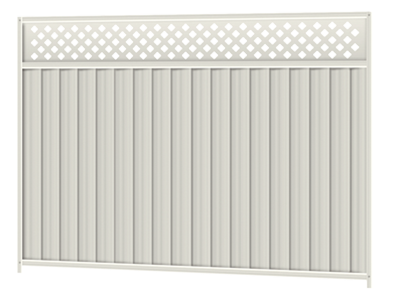
Lattice

Slat FX
Our Sheets, Posts & Rails
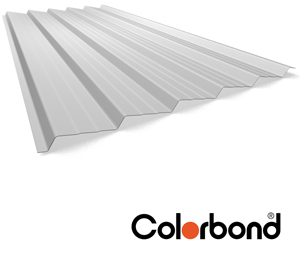
Sawtooth Profile
0.35mm BMT
Colorbond Sawtooth Profile is a premium fencing solution that is designed to offer both aesthetic appeal and functional benefits. This type of fencing ensures that your fence looks great from both sides, which is a crucial feature that adds value to your property.

Trimline Profile
0.35mm BMT
The Trimline Profile is a highly sought-after fencing profile that is known for its versatile design and aesthetic appeal. This type of profile features a ribbed profile that is designed to match traditional cladding, roofing, and guttering.
Panel & Gate Components
Standard
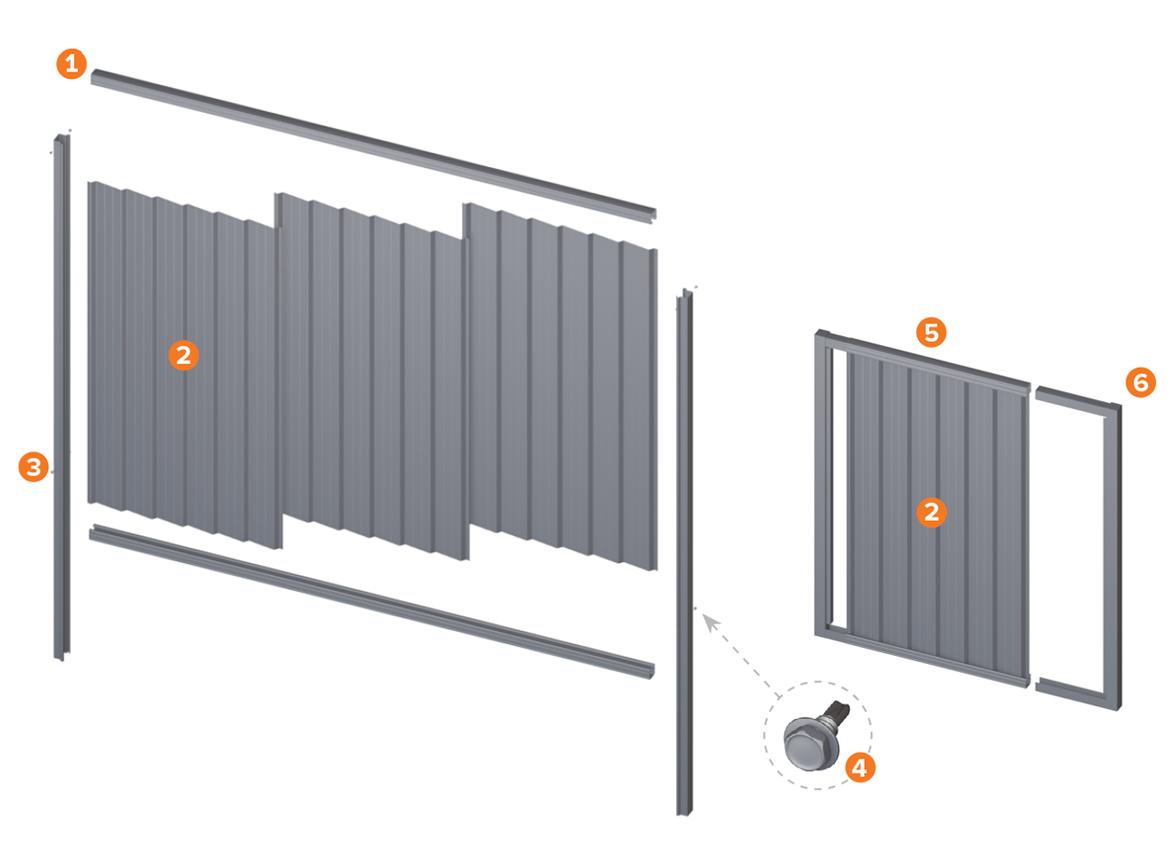
Panel & Gate Components
- Panel Rail
- Infill Sheet
- Channel Post
- Tek Screws
- Gate Rail
- Gate Stile
-
2400mm Panel
- 3x Infill Sheets
- 2x Channel Posts
- 2x Rails @ 2400mm
- 12x 10-16*16 Screws
-
930mm Gate
- 1x Infill Sheet
- 2x Gate Stiles
- 2x Rails @ 830mm
- 16x 10-16*16 Screws
-
3180mm Panel
- 4x Infill Sheets
- 2x Channel Posts
- 2x Rails @ 3180mm
- 12x 10-16*16 Screws
-
1720mm Gate
- 2x Infill Sheets
- 2x Gate Stiles
- 2x Rails @ 1620mm
- 16x 10-16*16 Screws
Breezeway / Lattice / Slat FX

Panel & Gate Components
- Panel Rail
- Infill Sheet
- Channel Post
- Tek Screws
- Gate Rail
- Gate Stile
- Breezeway Infill
- Breezeway Gate Infill
-
2400mm Panel
- 3x Infill Sheets
- 2x Channel Posts
- 2x Rails @ 2400mm
- 1x Breezeway Infill Kit
- 16x 10-16*16 Screws
-
930mm Gate
- 1x Infill Sheet
- 2x Gate Stiles
- 3x Rails @ 830mm
- 1x Breezeway Gate Infill
- 24x 10-16*16 Screws
-
3180mm Panel
- 4x Infill Sheets
- 2x Channel Posts
- 2x Rails @ 3180mm
- 1x Breezeway Infill Kit
- 16x 10-16*16 Screws
-
1720mm Gate
- 2x Infill Sheets
- 2x Gate Stiles
- 3x Rails @ 1620mm
- 1x Breezeway Gate Infill
- 24x 10-16*16 Screws
For Lattice or Slat FX Panels & Gate setups: Replace the relative Breezeway Infills mentioned above with Lattice or Slat FX Infills.
Installation Considerations
When it comes to installing Colorbond® steel fencing, there are several important considerations that should be taken into account. To ensure the stability and longevity of your fence, it's essential to install it in soil that is both stable and adequately compacted. This will prevent the fence from shifting or leaning over time, which could compromise its strength and security.
If your fence is being installed on sloping ground, longer posts may be required to ensure that it is installed correctly. Wind loads are also a crucial consideration when it comes to Colorbond® steel fencing, particularly in areas that are prone to strong winds. To ensure that your fence is secure, you may need to use longer posts, deeper footings, or additional bracing.
Proper ground preparation is essential for any successful fence installation. This may involve removing any rocks or debris, leveling the ground or removal of trees and shrubs along the fence line to ensure it is free from materials that could cause the fence to shift over time.
To provide additional protection for your Colorbond® steel fence posts, post caps can be installed to prevent water penetration and rust/corrosion over time.
By taking these considerations into account during your Colorbond® steel fence installation, you can ensure that your fence is both aesthetically pleasing and highly functional for years to come.

Uneven Ground
If the ground is not level where your fence is being installed you will need to consider if the fence will be stepped or raked to follow the slope of the ground.
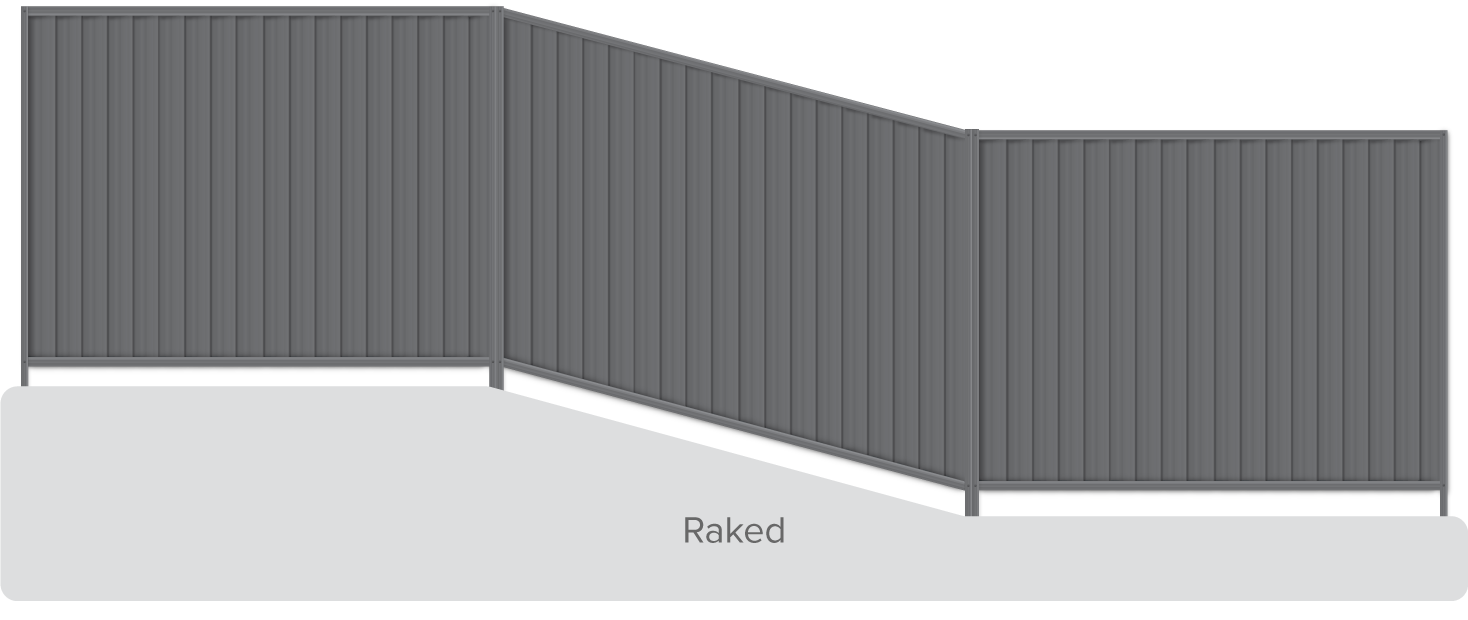
Raking
Longer sheets will be required for raked sites as you need to cut the sheets to the same degree as your sloping land. Longer rails will be required if your panel rakes more than 150mm over a 2400mm panel length (approx 4 degrees rake) .
Cutting Sheets
When cutting your sheets to suit sloping land, your cut angle is determined directly by the slope angle of the land you are installing on. The preferred method of cutting sheets is to use a nibbler or tin snips.
In addition to using the proper cutting tool and safety precautions, it is also essential to measure the slope angle accurately before proceeding with the cutting process. This will help ensure that the sheets fit snugly against the surface and prevent water from penetrating.


Stepping
Sloped ground can also be dealt with by stepping panels down a slope. This option requires no cutting of sheets, but for panels stepping more than 100mm, we recommend using longer posts for these panels.
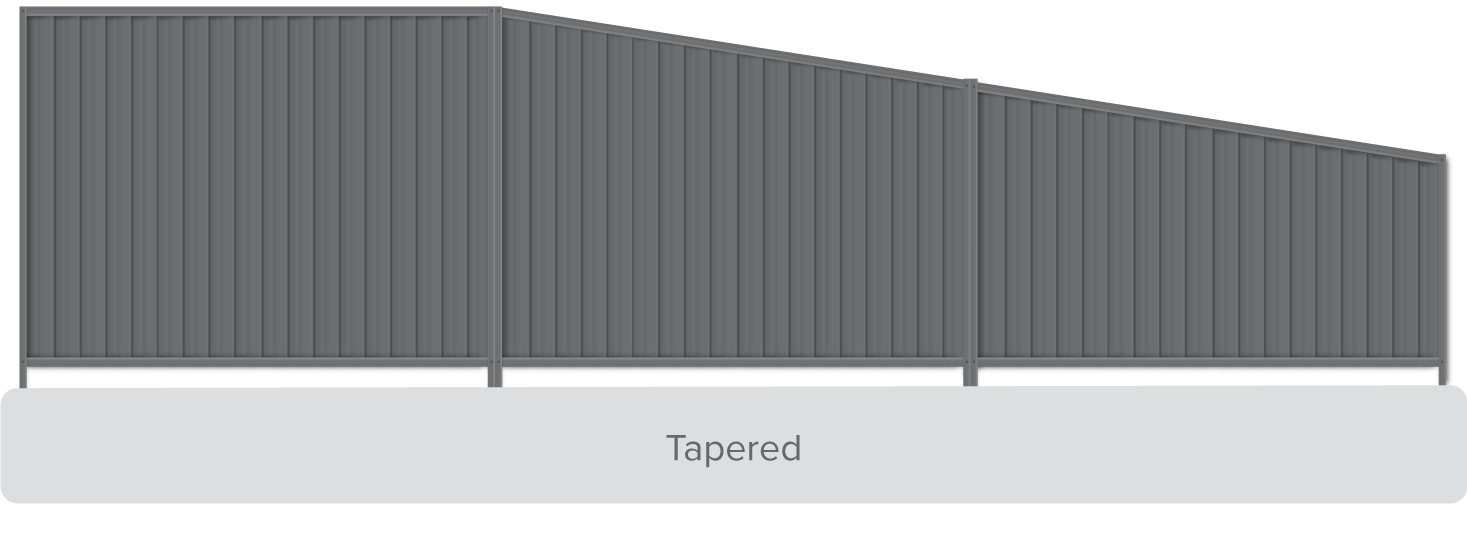
Tapering
You may consider tapering the end of your fence over the last few panels where there is no fence adjoining the corner. This is required for cyclone rating, unless you live in Wind Region A or Terrain Category 3 of Region B.
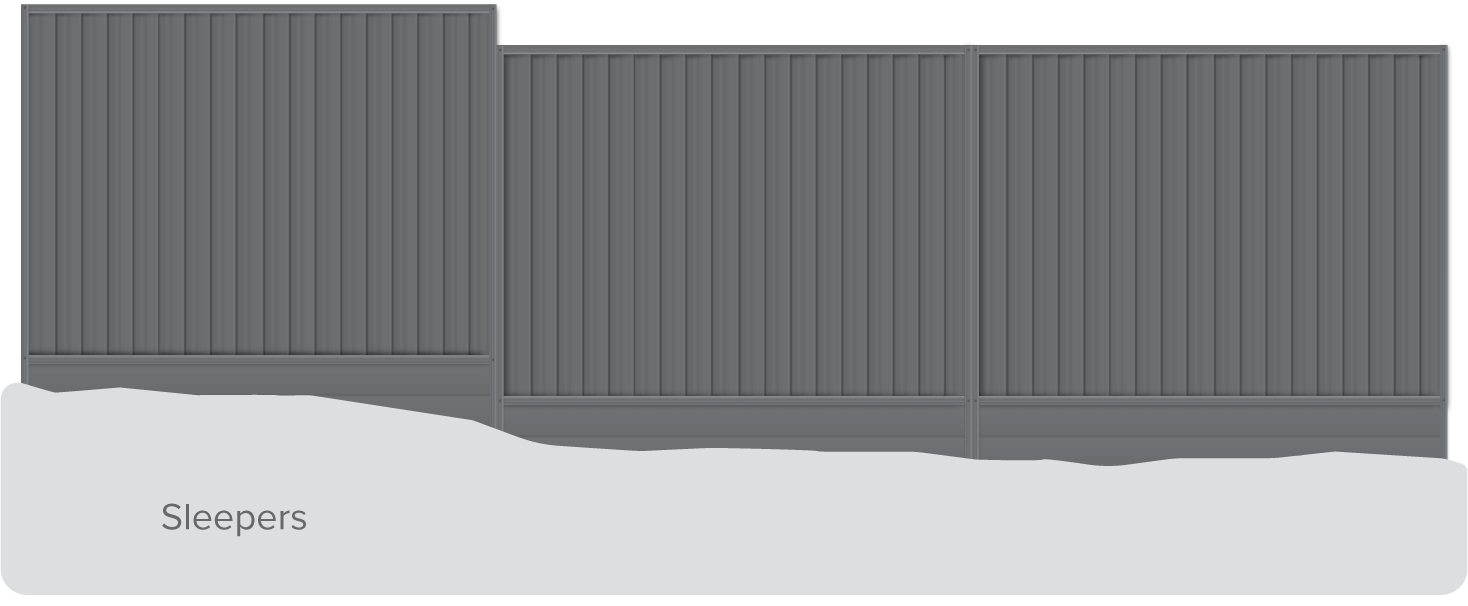
Sleeper
Our powder coated Aluminium Under Panel Sleepers can be installed under Colorbond Panels to counter uneven gaps under your fenceline caused by undulating land.
Aluminium Under Panel Sleepers
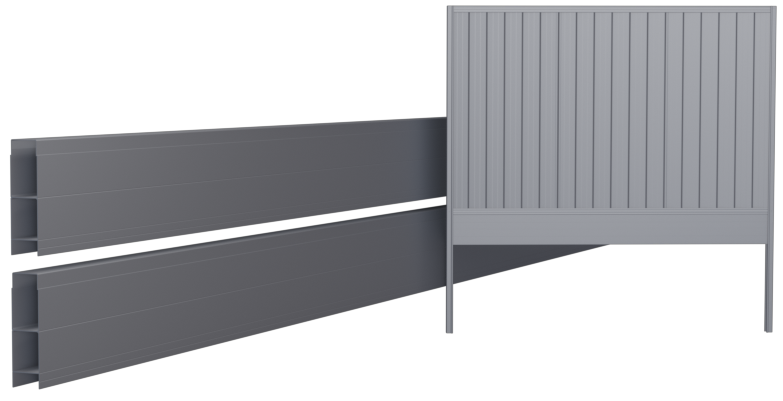
When installing Colorbond® Steel Fencing, it's common to use timber sleepers to retain the soil. However, aluminium sleepers are an superior alternative option that can be used. They are lightweight, durable, and resistant to termite damage, making them a popular choice for under panel sleepers.
Our Aluminium Under Panel Sleepers, designed to fit neatly within our Colorbond® Channel posts, can be used to finish of the underside of your fence run or counter uneven gaps under your fence line.
Please note: Aluminium Under Panel Sleepers are not recommended for use as retaining wall elements. We recommend using a maximum of 2 x Sleepers under each panel.

